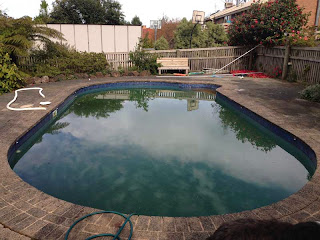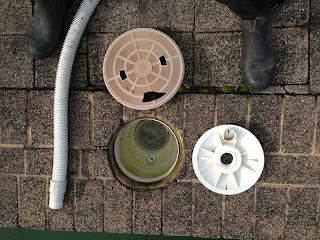 |
| It really looked this green |
Actually that's not strictly true. The first step we took towards rectifying the green pool problem was to get some information, and some good advice from a pool professional.
Thinking I was doing the right thing, I took a nice big sample of pool water down to our local Clark Rubber shop. Why Clark Rubber? Well they do sell rubber but they also sell a huge range of pool accessories, and most stores have a pool specialist on hand.
What I thought I needed was to check the Ph level for acidity or alkalinity, as well as the chlorine level. So in we went, green murky water in a jar, to the local shop. The water actually looked as if it was full of troll bogeys from Harry Potter. Eeeew.
 |
| This water is meant to be clear |
When we got there, the pool expert politely explained that we could measure the chlorine level, but the amount of algae and bacteria in the pool water meant that we had several things to deal with
These were :
All of the biological activity in the water would mean that the acidity level - or PH - would change constantly. So we had to stop that before addressing anything else.
And that the salt water chlorinator woukd not, on its own, be able to reverse the green pool situation. The pools chlorine level was very low - way under the required concentration to kill algae and bugs. The bacteria in the pool was due to the backswimmers and frogs living and excreting in the water.
We needed to shock dose the pool with chlorine and add an algicide. If you don't know what an algicide is, its a chemical that kills algae. I think it was a potassium based chemical because it was purple.
These chemicals cost about 70 dollars or so, and while we were there we also bought a new pool vacuum head for about $40. As you may have seen in our earlier post about what sorts of pool tools you might need compared with what we had received you will know why.
So in went the chemicals. Bearing in mind that this is a salt water chlorinated in ground pool of about 35,000 liters in volume that's not exactly expensive. I would say quite cheap.
The concentrated chlorine was in a solid granulated form, and we had to dissolve it first in a bucket of water, then add it to the pool while the filter was running. If we had added straight solid chlorine granules to the pool it apparently could have damaged the liner.
The algae killing chemical was a liquid, and the whole lot went straight in. Then we ran the filter and pump for a while, This spread the chemicals throughout the pool.
It took about ten days for the chemicals to do their job. The green slowly faded, and the pool became clearer but was still a bit murky.
Next step : Balancing the water and adding salt so the electrolytic chlorine converter could do its job!
No comments:
Post a Comment